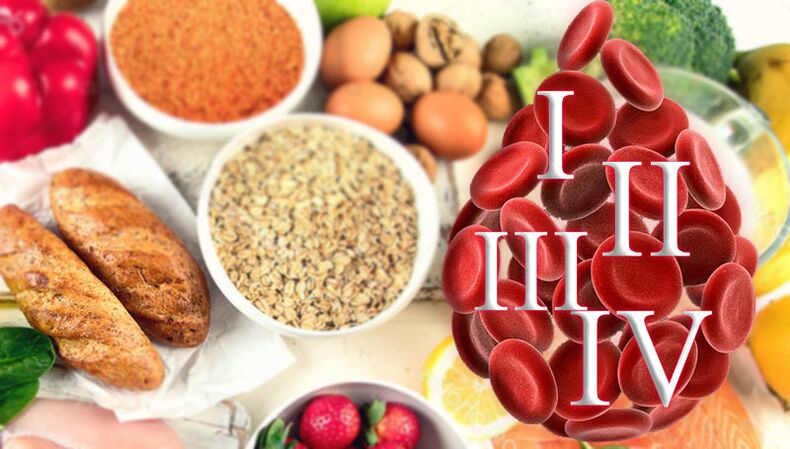The method of feeding by blood type was developed by American doctor Peter D'Adamo. According to his theory, the digestibility of food and the efficiency of its use by the body are directly related to human genetic characteristics. Namely, with his blood type. For the normal functioning of the immune system and the digestive system, a person must consume foods that correspond to the blood type, that is, those that his ancestors ate in ancient times. Elimination of blood-incompatible substances from the diet reduces the formation of slag in the body, improves the functioning of internal organs, promotes weight loss. Consumption of the same "foreign" products leads to the decontamination of the body and the rapid growth of body fat.

The theory of diet by blood type has sparked heated debates among doctors that have not subsided to this day. Based on D’Adamo’s technique, various diets per blood type have been developed, which have recently become very fashionable. According to D'Adamo, how should people of different blood types eat?
Food according to the first blood group
People with blood type 1 (0) and called "hunters" must rely on animal proteins and deny bread, pasta, and dairy products.
Blood type 1 (0) is the oldest and most common. People of the first blood type are meat consumers who have a persistent digestive system, an overactive immune system, and poor adaptation to new diets. The digestive system of the "hunters" has not yet adapted to dairy products and grains.
Especially useful products
Lean meat (lamb, beef), salmon, cod, pike, olive oil, walnuts, pumpkin seeds, beets, figs.
Foods to be restricted
Dairy products, cheeses, cottage cheese, fatty meats, especially pork, pasta and other products made from flour, potatoes, strawberries, tangerines, oranges, melons, avocados, corn and peanut butter, olives.
Weight gain foods
Wheat, corn, beans, beans, cabbage, cauliflower.
Dieting foods
Red meat, liver, seafood.
Nutrition according to the second blood group
A vegetarian meal recommended for blood group 2 (A) members, "farmers. "
The appearance of blood group 2 (A) is associated with the transition of people to agriculture. The owners of the second blood group are vegetarians with sensitive digestive systems. They need environmentally friendly natural food. Those with the second blood type must exclude meat from their diet: if meat is burned as fuel in the bodies of "hunters", it is converted into fat in "farmers". Dairy products are also poorly assimilated. But "farmers" can consume a wide variety of low-fat natural products, vegetables and cereals.
Especially useful products
Seafood in moderation, soy, beans, beans, buckwheat, rice, artichokes, Jerusalem artichokes, vegetable oils, soy products, vegetables and pineapples.
Foods to be restricted
Wheat bread, potatoes, apricots, blueberries, ketchup, mayonnaise. It is advisable to completely exclude meat and meat products from the diet.
Weight gain foods
Meat, dairy products, beans, wheat.
Dieting foods
Vegetable oils, soy products, vegetables, pineapple.
Nutrition according to the third blood group
Blood type 3 (B) appeared when human tribes began migrating north in an area with harsh climates. This is why the owners of the third blood type call D'Adamo "nomads. "They have a strong immune system and are more free to choose food than those in blood groups 1 and 2. The "nomads" are the main consumers of milk. The harmonious combination of physical and mental activity helps maintain their shape and good mood.
Soy, chicken, sunflower oil, tomatoes and pomegranates are contraindicated in the third blood type, all dairy products, fish, lamb, rabbit meat and flaxseed oil are useful.
Especially useful products
Lamb, rabbit, mackerel, cod, flounder, goat's milk cheese, olive oil, oatmeal, rice, parsley, cabbage, pineapple, plums.
Foods to be restricted
Goose meat, chicken meat, beef, pork, heart, shrimp, anchovies, lobster, eel, sunflower, peanut and corn oil, buckwheat, rye bread, tomatoes, pomegranate, persimmons.
Weight gain foods
Corn, lentils, peanuts, buckwheat, sesame seeds.
Dieting foods
Red meat, liver, liver, low-fat dairy products, green vegetables, eggs.
Nutrition according to the fourth blood type
Blood type 4 (AB) appeared less than a thousand years ago as a result of a mixture of other groups. Hence the name "new people". People with blood type 4 respond quickly to changes in the environment and diet. They have a sensitive digestive system and an overly tolerant immune system. The best way to keep fit is to combine mental work with light physical activity.
The diet of the owners of the fourth blood group should be sour milk-free foods, lamb, deer, vegetables and fruits.
The set of extra pounds is affected by mixed inheritance. In order to lose weight, owners of 4 blood groups must limit their meat consumption and combine it with vegetables. Inheritance of B ancestors is a negative insulin reaction in beans, corn, buckwheat, and sesame seeds. But thanks to the A-ancestors, their body is good for lentils and peanuts. In contrast to both, AB people respond well to wheat.
Especially useful products
Lamb, turkey, cod, mackerel, dairy products, corn oil, oatmeal, wheat bread, green spices, blueberries, pineapple.
Foods to be restricted
Beef, bacon, duck, flounder, crab, salmon, whole milk, olive oil, pumpkin seeds, beans, buckwheat, radish, avocado, banana, pomegranate.
Weight gain foods
Red meat, beans, corn, buckwheat, wheat.
Dieting foods
Seafood (excluding canned, dried, dried and smoked), soya, dairy products, green vegetables, pineapples.
A little conclusion
Above are the foods typical of the diet of each blood type. However, we all have our own individual characteristics. Therefore, when choosing foods, the choice of diet by blood group should take into account not only the general recommendations, but also the individuality, above all the origin and blood type of the ancestors.
Physicians have not yet reached a consensus on how effective blood group nutrition is, although most nutritionists at least consider this theory valid. In patients with any chronic disease, the diet should be used with extreme caution and the doctor should be consulted.






























